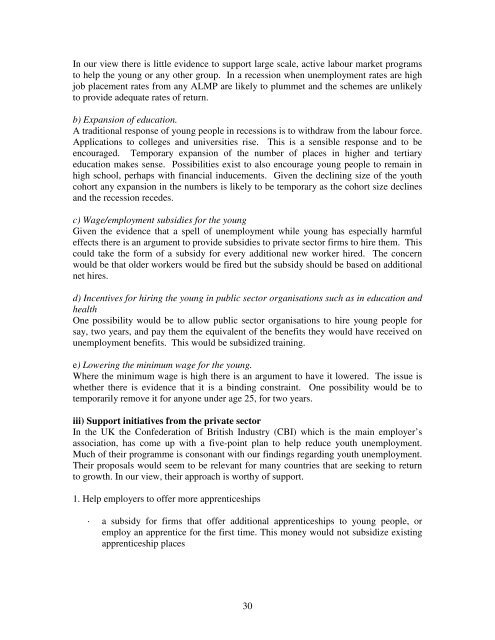Youth Unemployment: Déjà Vu? - Index of - IZA
Youth Unemployment: Déjà Vu? - Index of - IZA
Youth Unemployment: Déjà Vu? - Index of - IZA
Create successful ePaper yourself
Turn your PDF publications into a flip-book with our unique Google optimized e-Paper software.
In our view there is little evidence to support large scale, active labour market programs<br />
to help the young or any other group. In a recession when unemployment rates are high<br />
job placement rates from any ALMP are likely to plummet and the schemes are unlikely<br />
to provide adequate rates <strong>of</strong> return.<br />
b) Expansion <strong>of</strong> education.<br />
A traditional response <strong>of</strong> young people in recessions is to withdraw from the labour force.<br />
Applications to colleges and universities rise. This is a sensible response and to be<br />
encouraged. Temporary expansion <strong>of</strong> the number <strong>of</strong> places in higher and tertiary<br />
education makes sense. Possibilities exist to also encourage young people to remain in<br />
high school, perhaps with financial inducements. Given the declining size <strong>of</strong> the youth<br />
cohort any expansion in the numbers is likely to be temporary as the cohort size declines<br />
and the recession recedes.<br />
c) Wage/employment subsidies for the young<br />
Given the evidence that a spell <strong>of</strong> unemployment while young has especially harmful<br />
effects there is an argument to provide subsidies to private sector firms to hire them. This<br />
could take the form <strong>of</strong> a subsidy for every additional new worker hired. The concern<br />
would be that older workers would be fired but the subsidy should be based on additional<br />
net hires.<br />
d) Incentives for hiring the young in public sector organisations such as in education and<br />
health<br />
One possibility would be to allow public sector organisations to hire young people for<br />
say, two years, and pay them the equivalent <strong>of</strong> the benefits they would have received on<br />
unemployment benefits. This would be subsidized training.<br />
e) Lowering the minimum wage for the young.<br />
Where the minimum wage is high there is an argument to have it lowered. The issue is<br />
whether there is evidence that it is a binding constraint. One possibility would be to<br />
temporarily remove it for anyone under age 25, for two years.<br />
iii) Support initiatives from the private sector<br />
In the UK the Confederation <strong>of</strong> British Industry (CBI) which is the main employer’s<br />
association, has come up with a five-point plan to help reduce youth unemployment.<br />
Much <strong>of</strong> their programme is consonant with our findings regarding youth unemployment.<br />
Their proposals would seem to be relevant for many countries that are seeking to return<br />
to growth. In our view, their approach is worthy <strong>of</strong> support.<br />
1. Help employers to <strong>of</strong>fer more apprenticeships<br />
· a subsidy for firms that <strong>of</strong>fer additional apprenticeships to young people, or<br />
employ an apprentice for the first time. This money would not subsidize existing<br />
apprenticeship places<br />
30
















